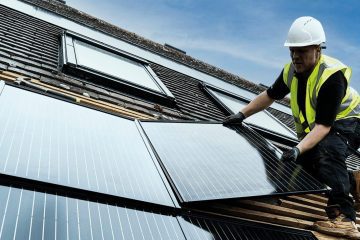Table of Contents
- Impact of Solar Panels on Property Value
- Understanding the Return on Investment for Solar Installations
- The Role of Location in Solar Panel Value Enhancement
- Factors That Influence the Market Appeal of Solar Homes
- Maximizing Your Homes Value Through Strategic Solar Upgrades
- Q&A
- Key Takeaways
Impact of Solar Panels on Property Value
The installation of solar panels has become a notable trend in enhancing the value of residential properties. Homebuyers are increasingly drawn to energy-efficient features, and solar panels offer more than just sustainability—they also promise lower electricity bills and energy independence. As a result, properties equipped with solar energy systems can fetch higher prices compared to similar homes without these installations. Research has shown that homes with solar panels can sell for a premium, often recouping more than the initial investment upon sale.
Several factors influence how much solar panels can positively affect property value. These include:
- Geographical Location: Homes in areas with high sunlight exposure and energy costs see the most significant increases in value.
- System Size and Quality: A larger, higher-quality solar system can result in a more substantial uplift in property price.
- Market Conditions: A competitive real estate market often amplifies the value added by energy-efficient features like solar panels.
According to a recent study by Zillow, homes with solar panels can increase property values by an average of about $15,000. Here’s a quick comparison showing the potential increase across various states:
| State | Average Increase in Home Value |
|---|---|
| California | $24,000 |
| New York | $18,000 |
| Texas | $12,000 |
This data illustrates not only the financial incentives of installing solar panels but also reflects a growing consumer awareness and demand for greener living. As more buyers become eco-conscious, the presence of solar energy infrastructure is likely to become a standard expectation rather than a luxury, solidifying its role in real estate market dynamics.


Understanding the Return on Investment for Solar Installations
Investing in solar panels can significantly impact the economics of homeownership, primarily through energy savings and increased property values. Homeowners who install solar systems often see a rise in home marketability due to the growing demand for eco-friendly living. Buyers are increasingly willing to pay a premium for homes equipped with solar energy solutions, primarily for the long-term savings on energy costs. A well-implemented solar setup not only benefits the environment but also translates into tangible financial benefits.
To truly gauge the financial merits of solar installations, homeowners need to consider a few key factors:
- Energy Cost Savings: Reducation in monthly electricity bills can lead to substantial savings over time.
- Increased Home Value: Studies show that homes with solar panels sell for more than homes without them, often recovering the installation costs in the resale price.
- Incentives and Tax Credits: Many regions offer financial incentives that can offset upfront installation costs, enhancing ROI.
Understanding the potential financial return can be complex, but visualizing it through comparative data can help clarify the value addition of solar systems. Below is a simple table illustrating the estimated increase in home value based on the solar installation cost:
| Install Cost | Estimated Value Increase | ROI Percentage |
|---|---|---|
| $10,000 | $15,000 | 50% |
| $15,000 | $22,500 | 50% |
| $20,000 | $30,000 | 50% |
As reflected in the table, for each dollar spent on solar installation, homeowners can expect a significant return when it’s time to sell. This potential for enhanced home value, coupled with ongoing energy savings, positions solar panels as a savvy investment for those looking to improve both their financial standing and environmental impact.


The Role of Location in Solar Panel Value Enhancement
When considering the installation of solar panels, the geographic location of a property plays a crucial role in determining their value-enhancing capabilities. Firstly, areas with abundant sunshine naturally lend themselves to higher energy production, allowing homeowners to realize significant savings on utility bills. Properties in sun-drenched states like California, Arizona, or Florida often see a marked increase in their market value attributable to this efficiency in energy generation. In contrast, locations with frequent cloud cover or harsh winters may yield lower returns on solar investment.
Moreover, local policies and incentives dramatically affect the overall worth that solar panels can bring to a home. Many states offer rebates, tax credits, or other financial incentives aimed at promoting sustainable energy practices. This can make solar panels not just an eco-friendly option but a financially savvy choice as well. Homeowners should consider their region’s regulations and support for renewable energy, including:
- State renewable portfolio standards
- Net metering policies
- Local utility incentives
- State tax benefits
In addition, the neighborhood’s energy culture can further influence property value. Areas where green living and sustainability are prioritized often see a higher demand for homes equipped with solar technology. This trend is especially resonant in communities that actively promote clean energy solutions or have established solar co-ops. In these instances, not only do solar panels contribute to reduced energy costs, but they also bolster overall property appeal in the eyes of environmentally conscious buyers, who are increasingly willing to invest in sustainable homes.


Factors That Influence the Market Appeal of Solar Homes
When assessing the market appeal of homes equipped with solar panels, several key factors come into play that can significantly enhance or diminish their attractiveness to potential buyers. First and foremost, the energy efficiency of the solar system itself plays a vital role. Homebuyers are more inclined to invest in properties that come with high-efficiency solar panels, which can effectively reduce energy bills and ensure a sustainable living environment. The age, brand, and warranty of the solar technology also matter; newer and well-rated systems often fetch a premium.
Location is another critical element in determining the desirability of solar homes. Properties situated in sun-rich areas or regions with favorable solar incentives are more attractive to buyers. Buyers in these locations anticipate a quicker return on investment due to lower energy costs and potential rebates. There’s also a growing awareness and interest in environmental sustainability, which makes homes that utilize renewable energy sources appealing to eco-conscious buyers.
The overall aesthetic integration of solar panels into the home’s design can influence buyer perception as well. Homes that feature sleek, modern solar installations that harmonize with architectural styles tend to stand out positively in the market. Additionally, the presence of supporting infrastructure, such as battery storage and energy management systems, increases functionality and buyer interest. Here’s a brief overview of these factors:
| Factor | Influence on Market Appeal |
|---|---|
| Energy Efficiency | Higher savings on energy bills make the home more attractive. |
| Location | Sun-rich areas with incentives boost desirability. |
| Aesthetic Integration | Well-designed solar installations enhance curb appeal. |
| Supporting Infrastructure | Battery and management systems improve functionality, attracting buyers. |


Maximizing Your Homes Value Through Strategic Solar Upgrades
Investing in solar upgrades not only benefits the environment but also significantly enhances your property’s marketability. Homebuyers today are increasingly interested in energy efficiency, and by installing solar panels, you demonstrate a commitment to sustainability while reducing their future energy bills. The allure of lower utility costs can be a compelling selling point, attracting eco-conscious buyers who are willing to pay a premium for green features.
To maximize the value of your solar installations, consider choosing high-efficiency panels and reputable manufacturers. Homebuyers often seek warranties and performance guarantees, so invest in products that come with comprehensive service agreements. Additionally, integrating solar battery storage into your setup can provide further benefits, ensuring a reliable power supply during peak usage times and potential grid outages. Here are some essential upgrades to think about:
- Solar Battery Storage: Allows you to store excess energy for later use.
- Smart Energy Management Systems: Enhances the efficiency of energy use in your home.
- High-Efficiency Solar Panels: Provides more energy output with less space.
Lastly, it’s wise to document your solar investment and its impacts on energy savings. Providing potential buyers with a detailed breakdown of your system’s performance and utility savings over the years can build confidence in their decision. Below is a simple table that outlines possible savings, depending on the size of solar installations:
| System Size (kW) | Estimated Annual Savings | Payback Period (years) |
|---|---|---|
| 3 kW | $450 | 5 |
| 6 kW | $900 | 4 |
| 10 kW | $1,500 | 3 |
By strategically investing in solar upgrades, homeowners can effectively leverage rising energy costs to boost their property’s value, while also creating a more sustainable living environment. These forward-thinking choices can create a win-win situation—both financially and environmentally.



0 Comments